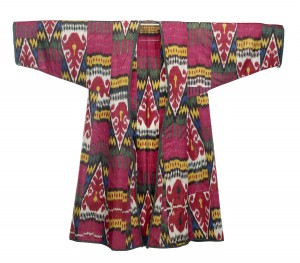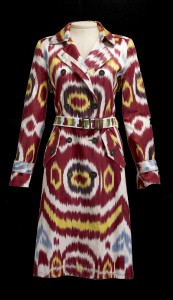The world of fashion is always on the move, creating new, bold and fresh ideas—whether from scratch or through re-invention of a tried and true concept. Definitive times that emphasize skirt or pant length, grunge or formal styles, and bright or natural colors, cycle through the years. Today is no exception, with dyeing techniques that are resurfacing with contemporary styles added to the equation.
Inspired by the resurgence of tie-dying in haute couture, Jill D’Alessandro, Curator for the de Young Museum, has eloquently captured a time continuum of objects and clothing that illustrate traditional and innovative dyeing techniques.
The To Dye For: A World Saturated in Color exhibit at the de Young Museum (through January 9, 2011) is a perfect inspiration source for your dyeing muse. Jill D’Alessandro has created a showcase of synchronicity with roots from hundreds of years ago that carries us through today. The exhibit demonstrates how oneness of technique and purpose doesn’t limit self-expression, but provides an unlimited realm of distinct results. What is striking is the personal expression that speaks through the dye medium – whether as a statement or an aura channeled through the wearer of the cloth. Each piece has a human hand that touched the cloth with purpose – a purpose that can be felt and that is alive with meaning.
Simply staged, an explanation and example of each dye technique is posted at the entrance. The pieces are grouped according to technique: tie dye, stitch resist, shibori; wax resist, ikat and mordant resist. From the ceremonial robe to haute couture, each object in the exhibition has a voice – ancient or modern – and it is distinctly heard. The care to detail, the balance of the design – each thread and color resonates with the cloth and tells the artist’s story. For instance, you can sense the pride of the woman who would have worn the Western Himalayan Coat of a High-Ranking Woman, just as you can feel the ease and grace in the modern Angelina DeAntonis Ocelot cape and dress ensemble. Cloth, when set to purpose, speaks volumes of both the creator and the wearer.
The relationship of artist and muse has had countless shapes and forms through out time, and continues to morph into new parameters with adoption of new technology. As fiber artists, we constantly call on our inner creative ability – transcending traditional ideas, rules, patterns and relationship to express new ideas, forms, methods or interpretations. Where do we find the inspiration – that state of someone or something who causes our mind and feelings to create that special object? Who owns those voices, what are they telling us, and what will we be inspired to create? Over time, the hand that wove the cloth was guided by a source of inspiration on the texture and color, fiber source, and where in the process something was modified (or not), to create an individual thing of beauty that we wear or display. And while necessity may be one catalyst, self expression is another, or even when we act as the medium to express another’s voice or wish.
For the objects displayed in this exhibit, inspiration was hosted by more than the traditional staples of silk, cotton, wool and modern fabrics. Tucked in between the expected there are surprises such as the bound resist dyed ceremonial skirt made from orchid fiber; the pandanus leaves mat (pandanus is a Thai fruit used in cooking and as a complement to chocolate); and the banana fiber ceremonial hanging.
Although it would have been easy to feel intimidated by all this creativity and energy, as an indefatigable neophyte weaver, I walked away with a profound respect for plain weave, which clearly demonstrated itself as a perfect foundation for infinite expression. I realized that it’s just as much about the message of the artist, as the structure or content of the weave.
After viewing the exhibit, I had the opportunity to speak with Jill about her inspiration for it, and how she decided to include Bay Area artists.
CC: When choosing the Bay Area artists for the exhibit, did you have a particular artist or a particular piece from the artist in mind?
JD’A: In most cases I knew the artist’s work very well, and of course some of the artists are represented in the de Young permanent collection – such as the Yoshiko Wada Coca-Cola kimono and works by Ana Lisa Hedstrom and Judith Content. It was important to both emphasize the preservation of techniques over time and to recognize our own Bay Area artists. From my perspective, outside of Japan many of the leading shibori artists reside in the Bay Area, so the exhibit would not be complete without them. Yoshiko Wada’s influence, in particular, has been very prominent. She taught ikat as early as 1973, and introduced shibori in 1975.
For example, Ana Lisa Hedstrom was in Yoshiko Wada’s first shibori class at the Berkeley Fiber Works and today is internationally recognized as a leader in the field. While we have several of her wearable art pieces in our collection, I decided after a studio visit to exhibit her newer work that is based on the art quilt. Likewise, despite having an arashi shibori work by Judith Content in our permanent collection, I choose to include her recent work , Marisma, because it utilizes the discharge technique. Visiting artists’ studios and homes allowed me to become more familiar with their work. While I had been familiar with Barbara Shapiro’s basketry work, I was immediately taken by her textile wall hangings that employ a combination of techniques. I strove to illustrate cross-cultural influences using the medium of resist dyeing. Coincidently, Angelina DeAntonis, another prominent artist, was actually invited to India to teach natural dye techniques. For centuries they were the leaders. Now, through our research and study we can give back. Reciprocity is cyclical!
It is well worth the effort to view this exhibit if you have the opportunity. You will not only be inspired to re-kindle your creative muse, you will also see how your own work is part of a continuum of artistic expression. It runs at the de Young through January 9, 2011. And if that is not enough inspiration, scarves and jewelry by some of the artists are available for sale at the kiosk right outside the exhibition.
http://deyoung.famsf.org/deyoung/exhibitions/dye-world-saturated-color
Conversations with the Artists
For more detail on the Bay Area artists included in the exhibit, click on the artist’s names to read about their craft, thoughts on creativity, and inspiration.
Barbara Shapiro Ana Lisa Hedstrom Angelina DeAntonis
Judith Content Yoshiko Wada

